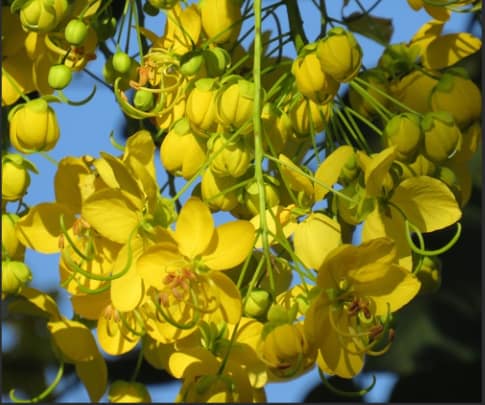
The long-tail Cassia abbreviata (Long-tail cassia) is ideal for small to medium-sized gardens where it will attract attention with both its beautiful deep yellow, sweetly scented flowers and its long seed pods.
🌍 Origin and Distribution of Cassia abbreviata
- Scientific Name: Cassia abbreviata
- Family: Fabaceae (legume family)
- Common Names: Long-tail cassia, Sjambok pod
- Native to: Sub-Saharan Africa (found in countries like Kenya, Tanzania, South Africa)
- Habitat: Savannas, woodlands, and dry forests.
Description
Cassia abbreviata subsp. beareana is a small to medium-sized deciduous tree up to 7 m high. Its slender to medium-broad trunk is covered in bark that ranges from dark brown to grey and black. In old trees the bark is often deeply furrowed.The leaves, which appear lightly drooping, are compound (one leaf made up of smaller leaflets), bright green when young and fade to a darker green when older.

The flowers, which can be seen from August to October, are deep yellow and appear clustered at the ends of the branches. They are sweetly scented. The pods appear soon after the flowers, are up to 80 mm long and cylindrical in shape. They ripen from a light green to a dark brown. The pods may take up to a year to ripen.

you may also like https://thrievly.com/cassia-javanica-java-cassia-pink-shower-tree/
🌳 Botanical Description of Cassia abbreviata
Type: Small to medium-sized tree
- Height: Grows up to 10–15 meters
- Leaves: Compound leaves with small leaflets
- Flowers: Bright yellow flowers in clusters
- Fruits: Long, dark brown seed pods that hang down
- Heartwood: Dark and rich in plant chemicals
🧪 Chemical Components of Cassia abbreviata
- Guibourtinidol: A flavonoid compound found in the heartwood; known for antioxidant and medicinal properties
- Other Compounds: Includes tannins and anthraquinones
you may also like https://thrievly.com/griffonia-simplicifolia/
Ecology
This tree is popular with both animals and humans. Various birds from our indigenous parrot species to the Go-away Bird eat the fruit pulp and seeds. Animals such as Nyala, Giraffe and Kudu browse the leaves. Elephants are also said to eat the leaves and the young branches of the tree.
🩺 Health Benefits and Uses of Cassia abbreviata
- Antioxidant Properties: Guibourtinidol and other compounds help protect cells from damage
- Traditional Medicine: Used in African traditional remedies for various ailments such as:
- Fever
- Malaria
- Diabetes
- Infections
- Wound Healing: Bark extracts are used on cuts and wounds
- Liver Health: Some research suggests it may help protect liver function
⚠️ Safety and Precautions for Cassia abbreviata
- Toxicity: Generally considered safe in traditional use, but not widely studied in modern clinical trials
- Use with Care: Should be used under guidance when taken in high doses or as extracts
📍 In India
- Hindi Name: Not commonly known or used in India; no widely recognized Hindi name
- Availability: Rare in India; not part of traditional Indian medicine but may be available through international herbal supplies



